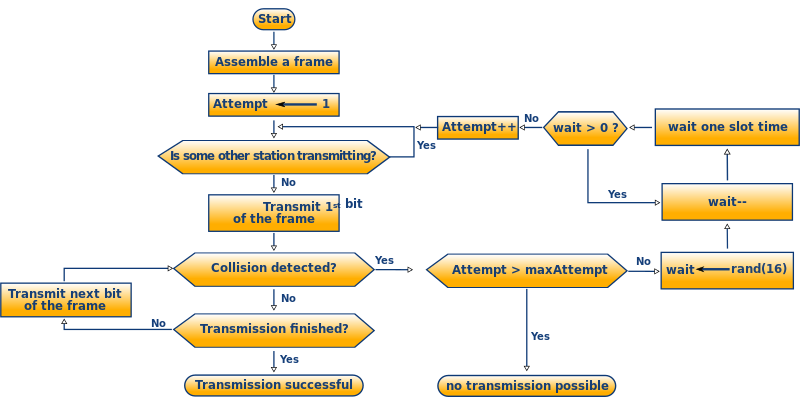Background
Suppose I have the following situation…
- PC with the NIC hard-coded to 100Mbps, Full-duplex
- RJ45 cable, pinned EIA-568B (not that the colors in the pinout matter)
- Cisco Catalyst 3560 Switch, using IEEE 802.3-1998 autonegotiation (10/100Mbps, only)
Since the PC's NIC is locked at 100/full, the Cisco's Ethernet autonegotiation fails and it falls back to 100/half. Now there is a duplex mismatch on the line. Now, let's assume the PC and the Cisco both transmit at exactly the same instant.
LOGICAL DIAGRAM
===============
Tx Tx
100/full -----> <----- 100/half
PC ------------------------------------- Cisco Catalyst 3560
PHYSICAL LAYER
==============
Tx D1 Tx on Rx D2??
-----> <------
568B 568B
Pin Signal Pin Signal
1 TX+ D1 --------------------------- 3 RX+ D2
2 TX- D1 --------------------------- 6 RX- D2
3 RX+ D2 --------------------------- 1 TX+ D1
6 RX- D2 --------------------------- 2 TX- D1
<------
Tx D1
CSMA/CD's flowchart looks like this…

My questions are specifically at the decision block for "Is some other station transmitting?" How exactly does this work at the physical layer?
Questions:
- Consider the PHYSICAL LAYER diagram. When the Cisco transmits at 100/half, is it only transmitting on pins 1 and 2 (marked Tx D1)? Intuition says this is true, but I want to be sure I understand how a 100BaseT Ether PHY's CSMA/CD works. I consider it possible that half-duplex would configure to transmit on all four pins (Tx D1 and Rx D2) since I have heard that the tx line driver inspects the transmitted signal to look for collisions.
- If the Cisco only transmits on 1 and 2 (Tx D1), does the Ether PHY register the collision because it senses the PC's transmit on pins 3 and 6 (Rx D2)? To me, it's counter-intuitive to register a collision if you have a dedicated Rx pair.
Please cite standards references for answers.
Best Answer
Half-duplex base-T Ethernet does not mean that the same wires are used for both directions of transmission, only that the two ends cannot transmit simultaneously.
Full-duplex means that both ends can transmit and receive at the same time, which only became possible with the shift from the shared coaxial cable to point-to-point unshielded twisted pair cabling.
There are never any physical collisions with base-T Ethernet, only "logical" collisions within a hub or switch. Even with Gigabit Ethernet, in which all four pairs are used in both directions simultaneously, each end uses a "digital hybrid" to separate incoming data from outgoing data on each pair.